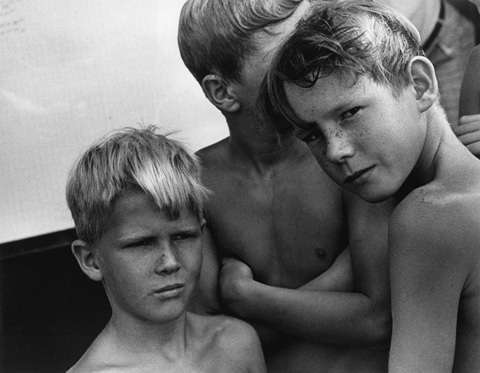
‘SAWYER BROTHERS, MCCREHAN POOL, CAMBRIDGE, MASS.’ Gelatin silver print, 11 by 14 inches, 1973, by Olive Pierce. |
Portland’s newest gallery is probably PhoPa, a collaboration between the Maine Media Workshops and College, curator Bruce Brown, and photographer Jon Edwards. Located on Washington Avenue, PhoPa shows photographs and works on paper (yes, the phonetic pun is intended). Past shows have included new photographs by Melonie Bennett, wood engravings by Siri Beckman, and photographic work by Brenton Hamilton.
PhoPa’s current Brown/Edwards endeavor focuses on Maine’s veteran social documentarian, Olive Pierce. Born in 1925, Pierce’s humanitarian concern was shaped by the Depression and seeing Auschwitz and Warsaw after World War II. She studied with Berenice Abbott and Paul Caponigro, but turned to documentary photography in 1967. For personal reasons Pierce stopped photographing in 1999 (although she took pictures at demonstrations in 2003 and produced an audio documentary in 2004), so PhoPa’s “Olive Pierce, Through the Years: 1964–1999 (photographs of children)” spans her entire career. While the show’s title seems to imply the focus on children as an afterthought, it is a valid concept for Pierce’s oeuvre.
The 35 gelatin silver prints are grouped by location: Maine, Iraq, and Cambridge — where Pierce lived much of her life. Half of the Maine photographs were published in 1996 in Up River: The Story of a Maine Fishing Community. Considering that the images are decades old and that many are of children absorbed in play, one might expect a sense of nostalgia. Not so. Even without much social background in the images, poverty is ever-present. The children seem somehow weighed down, and although Pierce’s own children are among the subjects, no visible distinction has been made. Nature, though, is always close, as are concerns with essential necessities such as food, communication, and nurture. Like all of Pierce’s black-and-white images in this show, the Maine scenes are slightly grainy, which seems perfectly
appropriate for their often hazy atmosphere.
The largest group of images was taken in Cambridge streets and housing projects. In this urban environment, children assume provocative stances, daring the photographer/viewer to do something about their behavior. A 1974 photograph shows a group of teenagers smoking and hanging out on a dilapidated sofa, insouciantly facing the camera. The dark rings under one boy’s eyes speak volumes. The children project independence and hard-won confidence, most likely fostered by relative adult abandonment. In this environment, only the companionship of equals seems to offer comfort.
Under the title No Easy Roses: A Look at the Lives of City Teenagers (1986), Pierce published photographs she took at the Cambridge high school where she taught in the 1970s and ’80s. The images on view capture teenagers learning, socializing, and dating — trying out adult roles and future professions. While these kids seem mostly oblivious to the camera, the Iraqi children and women in Pierce’s most recent series confront it straight on. In 1999, the photographer went to document children suffering from economic sanctions. These photographs, however, mostly present an eagerness to be seen (relative unfamiliarity with being photographed probably plays a role too). In this way, Pierce forces the viewer to make eye contact, and although her documentary approach is normally straightforward, even casual, here moral outrage occasioned a more pronounced agency.